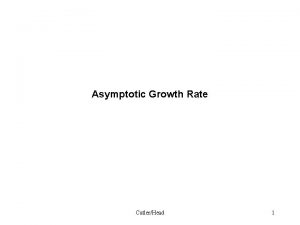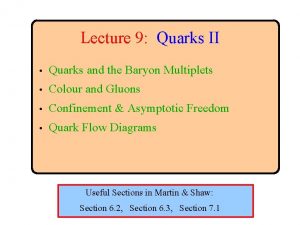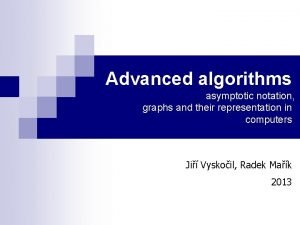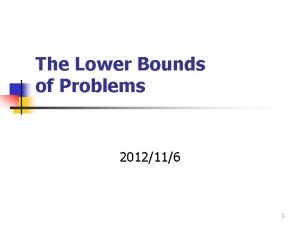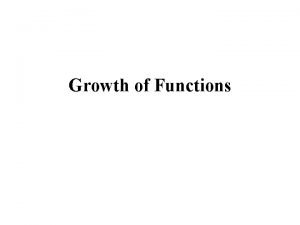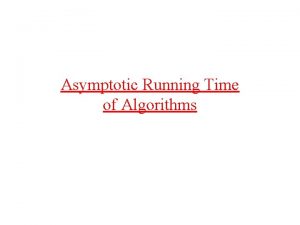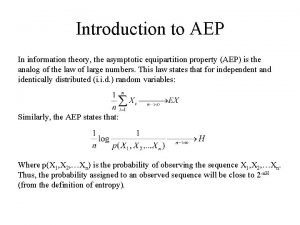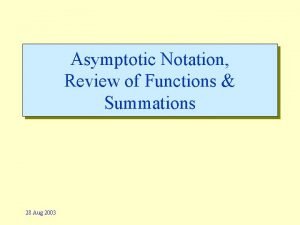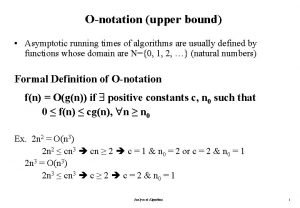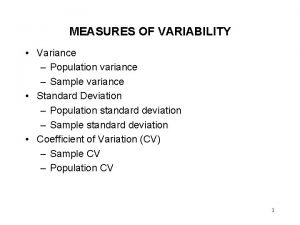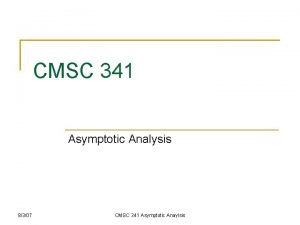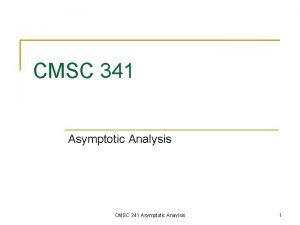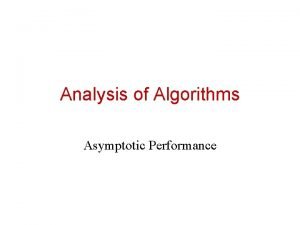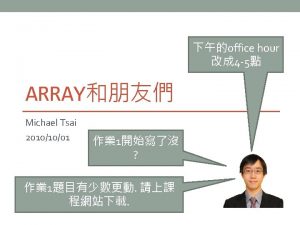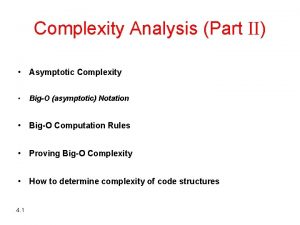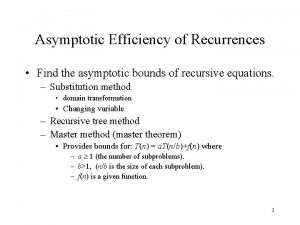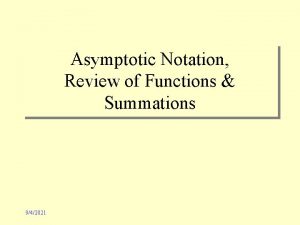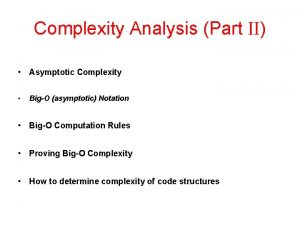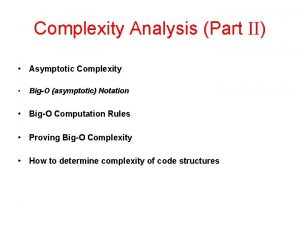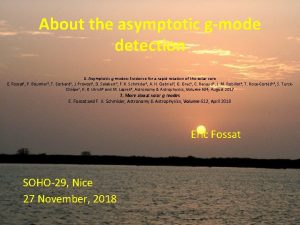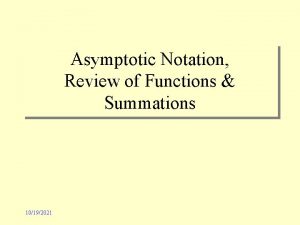The Asymptotic Variance of Departures in Critically Loaded




















- Slides: 20

The Asymptotic Variance of Departures in Critically Loaded Queues Yoni Nazarathy* EURANDOM, Eindhoven University of Technology, The Netherlands. (As of Dec 1: Swinburne University of Technology, Melbourne) Joint work with Ahmad Al-Hanbali, Michel Mandjes and Ward Whitt. MASCOS Seminar, Melbourne, July 30, 2010. *Supported by NWO-VIDI Grant 639. 072 of Erjen Lefeber

Overview • • • GI/G/1 Queue with number of served customers during Asymptotic variance: Balancing Reduces Asymptotic Variance of Outputs Main Result:

The GI/G/1/K Queue overflows Assume: Load: Squared coefficients of variation:

Variance of Outputs Asymptotic Variance Simple Examples: * Stationary stable M/M/1, D(t) is Poisson. Process( ): * Stationary M/M/1/1 with , D(t) is Renewal. Process(Erlang(2, )): Notes: * In general, for renewal process with : * The output process of most queueing systems is NOT renewal

Asymptotic Variance for (simple) After finite time, server busy forever… is approximately the same as when or

M/M/1/K: Reduction of Variance when

Summary of known BRAVO Results

B alancing R A educes Theorem (N. , Weiss 2008): For the M/M/1/K queue with symptotic V ariance of O utputs : Focus of this talk Conjecture (N. 2009): For the GI/G/1/K queue with : Theorem (Al Hanbali, Mandjes, N. , Whitt 2010): For the GI/G/1 queue with , under some further technical conditions:

BRAVO Effect (illustration for M/M/1)

The remainder of the talks outlines the proof and conditions for: Assume GI/G/1 with finite second moments and

3 Steps for Theorem 1: Assume that then is UI, , with Theorem 2: Theorem 3: Assume finite 4’th moments, then, Q is UI under the following cases: (i) Whenever and L(. ) bounded (ii) M/G/1 (iii) GI/NWU/1 (includes GI/M/1) (iv) D/G/1 with services bounded away from 0

Proof Outline for Theorems 1, 2, 3

Theorem 1: Assume that then is UI, , with Proof: D. L. Iglehart and W. Whitt. Multiple Channel Queues in Heavy Traffic. I. Advances in Applied Probability, 2(1): 150 -177, 1970. so also, If, then,

We now show: Theorem 1 (cont. ) is UI since A(. ) is renewal is UI by assumption

Theorem 2: Proof Outline: Brownian Bridge:

Theorem 2 (cont. ) Now use (e. g. Mandjes 2007), Manipulate + use symmetry of Brownian bridge and uncondition…. Quadratic expression in u Linear expression in u Now compute the variance.

Theorem 3: Proving is UI for some cases Assume (*) After some manipulation… Now some questions: 1) What is the relation between Q’(t) and Q(t)? 2) When does (*) hold? So Q’ is UI Some answers: 1) Well known for GI/M/1: Q’(. ) and Q(. ) have the same distribution 2) For M/M/1 use Doob’s maximum inequality: Lemma: For renewal processes with finite fourth moment, (*) holds. Ideas of proof: Find related martingale, relate it to a stopped martingale, then Use Wald’s identity to look at the order of growth of the moments.

Proposition: (i) For the GI/NWU/1 case: Going beyond the GI/M/1 queue (ii) For the general GI/G/1 case: C(t) counts the number of busy cycles up to time t Question: How fast does grow? Lemma (Due to Andreas Lopker): For renewal process with Zwart 2001: For M/G/1: So, Q is UI under the following cases: (i) Whenever and L(. ) bounded (ii) M/G/1 (iii) GI/NWU/1 (includes GI/M/1) (iv) D/G/1 with services bounded away from 0

Summary • Critically loaded GI/G/1 Queue: • UI of in critical case is challenging • Many open questions related to BRAVO, both technical and practical

References • Yoni Nazarathy and Gideon Weiss, The asymptotic variance rate of the output process of finite capacity birth-death queues. Queueing Systems, 59(2): 135 -156, 2008. • Yoni Nazarathy, 2009, The variance of departure processes: Puzzling behavior and open problems. Preprint, EURANDOM Technical Report Series, 2009 -045. • Ahmad Al-Hanbali, Michel Mandjes, Yoni Nazarathy and Ward Whitt. Preprint. The asymptotic variance of departures in critically loaded queues. Preprint, EURANDOM Technical Report Series, 2010 -001.
 What is the refusal of the call in the odyssey
What is the refusal of the call in the odyssey For inquiries please contact
For inquiries please contact Material yield variance arises due to change in the
Material yield variance arises due to change in the Asymptotic complexity examples
Asymptotic complexity examples Compare asymptotic growth rate
Compare asymptotic growth rate Notasi asimptotik
Notasi asimptotik Asymptotic freedom
Asymptotic freedom Asymptotic notation graph
Asymptotic notation graph Big o notation for for loop
Big o notation for for loop Asymptotic lower bound
Asymptotic lower bound Asymptotic performance
Asymptotic performance Asymptotic growth
Asymptotic growth Asymptotic run time
Asymptotic run time Notasi omega
Notasi omega Information theory asymptotic equipartition principle aep
Information theory asymptotic equipartition principle aep Transpose symmetry asymptotic notation
Transpose symmetry asymptotic notation Little omega
Little omega Asymptotically tight bound
Asymptotically tight bound Aseptic
Aseptic Critically thoughful
Critically thoughful Valid safeguards in antt
Valid safeguards in antt




